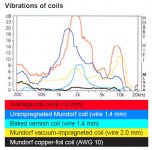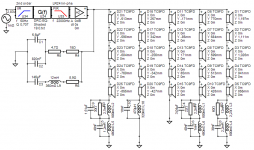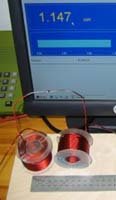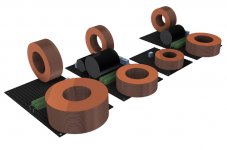Indeed the dark blue line in the middle left graph is the Power response.
We're only changing the vertical directivity, horizontal should not have changed.
Thanks for the tips on the crossovers. I plan to go for the phenolic boards with zip-ties.
I'll check if I can get them into the enclosure due to being somewhat wider than desired.
It should work, I want to make an effort to minimise the volume needed, but won't use
cored inductors. Still trying to make up my mind between a Mundorf L100 12 uF air core and
the Jantzen. The mundorf has a hair less resistance (probably not noticable) but is similar priced.
Op zoek naar air core spoelen? - SoundImports
The smaller inductors will all be Jantzen air core. This particular one isn't in stock and i am tempted to buy it separately
(instead of waiting two weeks) which gives me the option to choose between the above two.
We're only changing the vertical directivity, horizontal should not have changed.
Thanks for the tips on the crossovers. I plan to go for the phenolic boards with zip-ties.
I'll check if I can get them into the enclosure due to being somewhat wider than desired.
It should work, I want to make an effort to minimise the volume needed, but won't use
cored inductors. Still trying to make up my mind between a Mundorf L100 12 uF air core and
the Jantzen. The mundorf has a hair less resistance (probably not noticable) but is similar priced.
Op zoek naar air core spoelen? - SoundImports
The smaller inductors will all be Jantzen air core. This particular one isn't in stock and i am tempted to buy it separately
(instead of waiting two weeks) which gives me the option to choose between the above two.
Last edited:
With most of the fibreglass or phenolic boards they can be made smaller by scoring a line and snapping the board. That could be done with a sharp blade or a blade in a multi tool or angle grinder.
Lots of commercial boards are designed that way to be snapped off.
I got a multi tool to cut the nails in a window frame to remove it and it is amazing how many jobs that thing has come in handy for 🙂
Lots of commercial boards are designed that way to be snapped off.
I got a multi tool to cut the nails in a window frame to remove it and it is amazing how many jobs that thing has come in handy for 🙂
Back in the day, I used to carve PCB material up with a sabre (reciprocating) saw. Really easy to replace the blades if they wore out early.
I had a drill tool that could carve out an isolated pad from the copper for the occasional analog design. My digital prototypes were all wire wrap using boards drilled with an array of hole on .1" centers and power and ground tracks running between. I imagine home brewing is substantially more difficult in this SMT world but with easy availability of simulation, much less cut and try needed.
I had a drill tool that could carve out an isolated pad from the copper for the occasional analog design. My digital prototypes were all wire wrap using boards drilled with an array of hole on .1" centers and power and ground tracks running between. I imagine home brewing is substantially more difficult in this SMT world but with easy availability of simulation, much less cut and try needed.
I think I found my answer on the coils. The Mundorf air coil series is baked from the BL series on while the Jantzen coils are baked by standard:
Air Core Wire Coil - Jantzen-audio.com
I stumbled over a graphic from Mundorf coils that made me doubt a bit. But generally it tells you the most expensive coils perform the best 🙂.
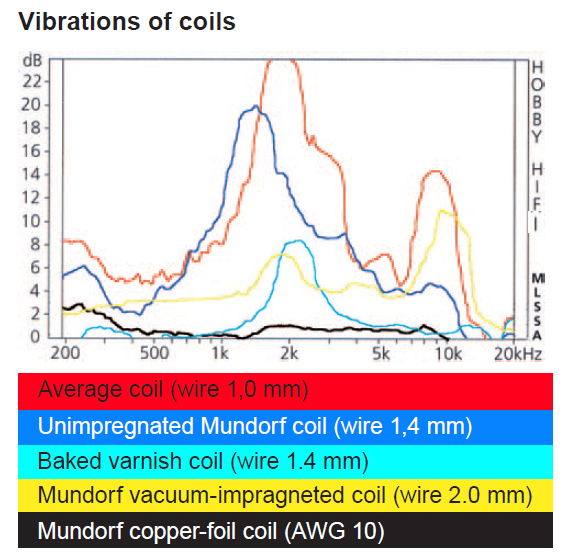
The L100 series has none of the treatments to make it more quiet. It would represent the dark blue coil. The BL series are the baked (light blue) version on this list. It seems the Jantzen are baked already (see link above).
Air Core Wire Coil - Jantzen-audio.com
I stumbled over a graphic from Mundorf coils that made me doubt a bit. But generally it tells you the most expensive coils perform the best 🙂.
The L100 series has none of the treatments to make it more quiet. It would represent the dark blue coil. The BL series are the baked (light blue) version on this list. It seems the Jantzen are baked already (see link above).
Attachments
I guess I'm going to find out what this does after all the simulations(*). I just ordered the big bulk of components, still need a few parts that ship right away and those will have to wait for a suitable delivery moment. 🙂
It better be good (lol). This project is turning into a passive/active setup. The final schematic:
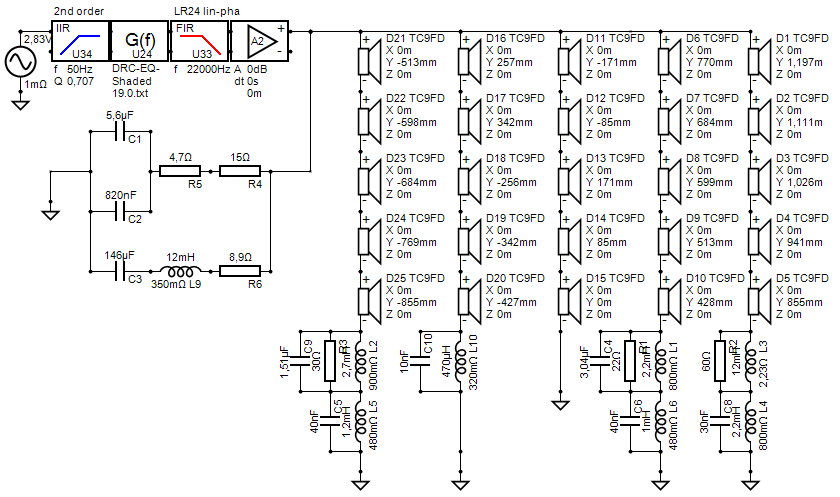
Don't get too excited, as it will take a long time before I'm able to test it all.
I'm kind of curious if other line array users are following this with possible plans to do something similar. My version is balanced for reasonable sound standing up and good sound at seated positions. Or that's what I hope it will do 😀.
I still have to source the parts for my 6 channel pré-amp... It's going to be a busy summer! At least I hope to push it all through.... It wouldn't be the first time that it all gets finished somewhere in December....
(*)= I just looked it up, I ran 52 separate simulations to come up with the above...
It better be good (lol). This project is turning into a passive/active setup. The final schematic:
Don't get too excited, as it will take a long time before I'm able to test it all.
I'm kind of curious if other line array users are following this with possible plans to do something similar. My version is balanced for reasonable sound standing up and good sound at seated positions. Or that's what I hope it will do 😀.
I still have to source the parts for my 6 channel pré-amp... It's going to be a busy summer! At least I hope to push it all through.... It wouldn't be the first time that it all gets finished somewhere in December....

(*)= I just looked it up, I ran 52 separate simulations to come up with the above...
Attachments
Last edited:
I think I found my answer on the coils. The Mundorf air coil series is baked from the BL series on while the Jantzen coils are baked by standard:
Air Core Wire Coil - Jantzen-audio.com
I stumbled over a graphic from Mundorf coils that made me doubt a bit. But generally it tells you the most expensive coils perform the best 🙂.
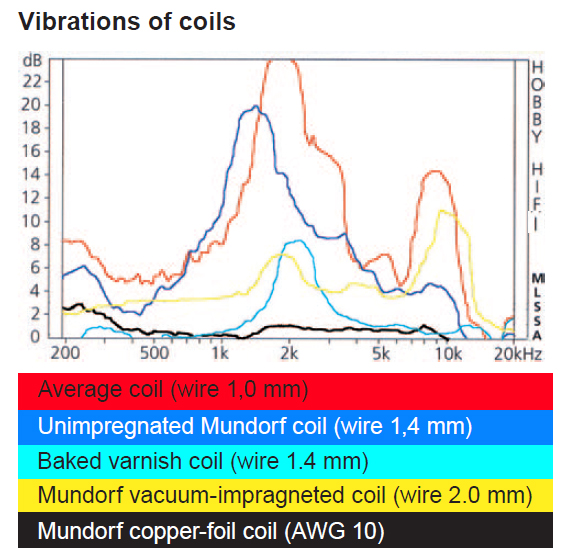
The L100 series has none of the treatments to make it more quiet. It would represent the dark blue coil. The BL series are the baked (light blue) version on this list. It seems the Jantzen are baked already (see link above).
Is it clear what has been measured? Solely mechanical aspects i.e. the coil was exposed to vibrations and then, by an accelerometer? the amount of vibration was measured? Or was there an electrical signal passing the coil, and then the resulting mechanical vibration was measured? Or was the coil vibrated and then the impact on an electrical signal was measured?
I don't get it...
22 dB is a lot...
//
Look up Hobby HiFi (4/2000, starting at page 66) to find that answer... 🙂
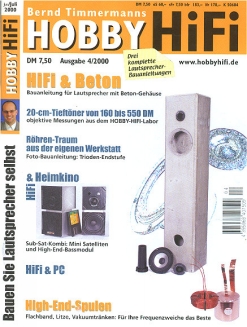
(sorry, I don't have the answer...)

(sorry, I don't have the answer...)
Last edited:
Here's another link to the graph in german: Mundorf Spulenvibrationen
And I figured Mundorf would be proud enough to say something:
Anmeldung zum Informationsservice
Sadly they did not publish the article at that time... but they did mention this:
So an email to Mundorf might give us the original article...
I filed a request for the information in the contact form at Mundorf.com.
And I figured Mundorf would be proud enough to say something:
Anmeldung zum Informationsservice
Sadly they did not publish the article at that time... but they did mention this:
Auf Wunsch senden wir Ihnen gerne den kompletten Testbericht zu.
So an email to Mundorf might give us the original article...
I filed a request for the information in the contact form at Mundorf.com.
Last edited:
I think I found my answer on the coils. The Mundorf air coil series is baked from the BL series on while the Jantzen coils are baked by standard:
Air Core Wire Coil - Jantzen-audio.com
I stumbled over a graphic from Mundorf coils that made me doubt a bit. But generally it tells you the most expensive coils perform the best 🙂.

The L100 series has none of the treatments to make it more quiet. It would represent the dark blue coil. The BL series are the baked (light blue) version on this list. It seems the Jantzen are baked already (see link above).
Any idea at what level/power these coils where measured?
Absolute levels are needed to determine audibility of the own accoustic noise generated by these coils...
btw, I also heard sound coming from capacitors, would be interesting to see these measured also.
But... this all disappears with active cross overs 😀
Here's another link to the graph in german: Mundorf Spulenvibrationen
And I figured Mundorf would be proud enough to say something:
Anmeldung zum Informationsservice
Sadly they did not publish the article at that time... but they did mention this:
So an email to Mundorf might give us the original article...
I filed a request for the information in the contact form at Mundorf.com.
Yes, its still in their "boutique" catalogue. Publishing that without a comment is questionable... hmm. Looking forward to any answer.
//
Some speculation in a german forum... (go. tr.)
"Since I can not compare anything, I do not have 4 Concordes ...
404 Not Found
Article on vibration. Looks very convincing, but can I hear it when the coil produces 20 dB? No!
The question remains whether the vibration affects the sound? According to my test, rather no.
When searching the Internet on this topic, you will also find contributions from members of this forum who do not consider this vibration measurement to be meaningful, but also those who say that film spools have advantages in fine drawing and dynamics.
Anyway, I can rest easy.
Last edited by walwal; 01-23-2007 at 11:28 AM.
walwal is offline Reply with quote
Alt 23.01.2007, 16:28 # 100
farad
Registered user
Registered since: 09.2001
Posts: 5,775
Hello.
How could a vibration test look like? At Kirchner Elektronik there are the small accelerometer electret capsules. If you measure in a quiet environment, you should be able to measure the vibration directly on the wire winding. One would then only have to measure with a defined signal. The resonance frequency will stand out clearly. A sliding sine offers itself. One would measure the "vibration impulse response" of the coil. Unfortunately, very high currents are needed again. Or should the whole thing be measured at 1W at the 8Ohm chopper resistor?
Differences will certainly be audible in the whole box. But they are the same for every pair of the same structure. The sum of the tolerances changes a lot here.
Why should a film spool sound more spatial than a wire spool and not a wire spool more spatial than a film spool?
farad
Farad is offline Reply with quote
Old 01/23/2007, 6:04 p.m. # 101
whale
Registered user
Registered since: 01.2003
Location: 63150
Posts: 24,317
The measurements were probably made with a button at one point. This was criticized as insufficient and laser measurements over the entire "outer skin" were suggested, but it is probably too complex.
I am not convinced of the influence of the coils on the room.
walwal is offline Reply with quote
Old 01/23/2007, 9:21 PM # 102
farad
Registered user
Registered since: 09.2001
Posts: 5,775
btw: Is the scaling of the ordinate safe in dB SPL?
A switch makes a lot of noise! At high outputs, the PA switches sing along well. How critical that is in a box then ....
farad
Farad is offline Reply with quote"
//
"Since I can not compare anything, I do not have 4 Concordes ...
404 Not Found
Article on vibration. Looks very convincing, but can I hear it when the coil produces 20 dB? No!
The question remains whether the vibration affects the sound? According to my test, rather no.
When searching the Internet on this topic, you will also find contributions from members of this forum who do not consider this vibration measurement to be meaningful, but also those who say that film spools have advantages in fine drawing and dynamics.
Anyway, I can rest easy.
Last edited by walwal; 01-23-2007 at 11:28 AM.
walwal is offline Reply with quote
Alt 23.01.2007, 16:28 # 100
farad
Registered user
Registered since: 09.2001
Posts: 5,775
Hello.
How could a vibration test look like? At Kirchner Elektronik there are the small accelerometer electret capsules. If you measure in a quiet environment, you should be able to measure the vibration directly on the wire winding. One would then only have to measure with a defined signal. The resonance frequency will stand out clearly. A sliding sine offers itself. One would measure the "vibration impulse response" of the coil. Unfortunately, very high currents are needed again. Or should the whole thing be measured at 1W at the 8Ohm chopper resistor?
Differences will certainly be audible in the whole box. But they are the same for every pair of the same structure. The sum of the tolerances changes a lot here.
Why should a film spool sound more spatial than a wire spool and not a wire spool more spatial than a film spool?
farad
Farad is offline Reply with quote
Old 01/23/2007, 6:04 p.m. # 101
whale
Registered user
Registered since: 01.2003
Location: 63150
Posts: 24,317
The measurements were probably made with a button at one point. This was criticized as insufficient and laser measurements over the entire "outer skin" were suggested, but it is probably too complex.
I am not convinced of the influence of the coils on the room.
walwal is offline Reply with quote
Old 01/23/2007, 9:21 PM # 102
farad
Registered user
Registered since: 09.2001
Posts: 5,775
btw: Is the scaling of the ordinate safe in dB SPL?
A switch makes a lot of noise! At high outputs, the PA switches sing along well. How critical that is in a box then ....
farad
Farad is offline Reply with quote"
//
I think you could argue that there is no way for the coil to move/vibrate except in reaction to magnetic force exerted on some external object - such as another, nearby coil. But if that is happening, you've got the coils too close together for other reasons.
Audibility is another issue. No one who has heard transformer hum can be blamed for concern about the possibility of audibility.
Audibility is another issue. No one who has heard transformer hum can be blamed for concern about the possibility of audibility.
Basically the coil construction could have an effect on how prone it is to make noise. At least that's what I get from the graph. In that light, I was comparing the Jantzen coils to the L100 series from Mundorf. The L100 does not have the baked (better performing) construction, yet the Jantzen does mention it on their coil construction.
In that light one might conclude you don't want it mounted rigid to a hard surface? As that might amplify any sound that it makes.
I have seen the Troels measurements of mounting coils close together: Placement of coils in crossover networks
So my intent is to have the coils separated as far as my boards allow it, and have them aligned like this:
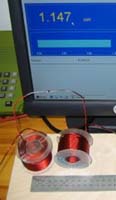
(and as far apart as I can get them)
I did like this comment:
I was surprised by some of the placement options used in the Humble Homemade HiFi gallery.
If audible differences do exist, they come from somewhere. I'm not equipped to find out the why's but am willing to practise a sensible approach.
I do somewhat believe in audible differences between capacitors, even if at first I did not want to buy into that. I liked this test: The "Sound" of Capacitors as at least "some" explanation that might give us a clue about measurable differences. Even if that test merely showed differences between capacitor types.
Heck, I'm turning into a true audiophile 🙂. It's just that differences can exist. So I try to stay open for the things that I can't explain away that easily. Yes I've heard differences in amps! Even between wires, which I was also able to measure (somewhere in this long thread).
The reason to do this frequency shading passively is because I don't want to use another amplifier, as I like that Goldmund beast a bit too much. Am I right? Who knows, but I am pleased with the decision. That's worth something to me.
My Musical Fidelity M1 DAC sounds different than my Xonar Essence ST card DAC as well. Observed by myself and my son. I knew what was going on, he didn't. Big difference there. He just noticed a changed sound. He did not want to pick a favorite. I did, I opted for the Musical Fidelity.
So even if I am not willing to fork out hundreds of Euro's for the best capacitors and coils, I do try to make it a reasonable compromise. I can't try everything I'd like to examine. Not without a sponsor anyway 😀.
In that light one might conclude you don't want it mounted rigid to a hard surface? As that might amplify any sound that it makes.
I have seen the Troels measurements of mounting coils close together: Placement of coils in crossover networks
So my intent is to have the coils separated as far as my boards allow it, and have them aligned like this:
(and as far apart as I can get them)
I did like this comment:
Dear Mr. Gravesen,
As I think you don't have much time as you are designing excellent speakers at this very moment I will try to make it short:
In my opinion, you measurements about the placement of coils won't show the whole truth or the real problem of placing coils next to each other. The real problem is the crosstalk, not the change in inductivity (although this is a little problem, too, even though the changes in inductivity stay below 10 %). It would be great if you could do the measurements again, but this time measure the crosstalk, too. You could do this by giving one coil a 50 Hz signal with a defined voltage and measuring the output voltage on the other coil. Or you could at least give a hint on your page that the change in inductivity is not the only effect...
I'm writing to you as in many internet boards people refer to your measurements and you are kind of a expert among the hobby loudspeaker designers...
Best Regards, B.M.
I was surprised by some of the placement options used in the Humble Homemade HiFi gallery.
If audible differences do exist, they come from somewhere. I'm not equipped to find out the why's but am willing to practise a sensible approach.
I do somewhat believe in audible differences between capacitors, even if at first I did not want to buy into that. I liked this test: The "Sound" of Capacitors as at least "some" explanation that might give us a clue about measurable differences. Even if that test merely showed differences between capacitor types.
Heck, I'm turning into a true audiophile 🙂. It's just that differences can exist. So I try to stay open for the things that I can't explain away that easily. Yes I've heard differences in amps! Even between wires, which I was also able to measure (somewhere in this long thread).
The reason to do this frequency shading passively is because I don't want to use another amplifier, as I like that Goldmund beast a bit too much. Am I right? Who knows, but I am pleased with the decision. That's worth something to me.
My Musical Fidelity M1 DAC sounds different than my Xonar Essence ST card DAC as well. Observed by myself and my son. I knew what was going on, he didn't. Big difference there. He just noticed a changed sound. He did not want to pick a favorite. I did, I opted for the Musical Fidelity.
So even if I am not willing to fork out hundreds of Euro's for the best capacitors and coils, I do try to make it a reasonable compromise. I can't try everything I'd like to examine. Not without a sponsor anyway 😀.
Attachments
Last edited:
Its often worth in to me to pay a little more so I don't have to worry or deal with an unknown. When buying an amp, for example, what distortion and noise specs are good enough?
That was an interesting capacitor test and comparison you linked. The possibility of hysteresis never occurred to me. I would have done a Z sweep.
Ideally, the ESR and other loss components of the caps are specified vs frequency.
That was an interesting capacitor test and comparison you linked. The possibility of hysteresis never occurred to me. I would have done a Z sweep.
Ideally, the ESR and other loss components of the caps are specified vs frequency.
Ordered the rest of the stuff today...
I'll need to cut the boards (went with the black phenolic boards) to get them to fit with the biggest coil. I do have a multi-tool so that should take care of it.
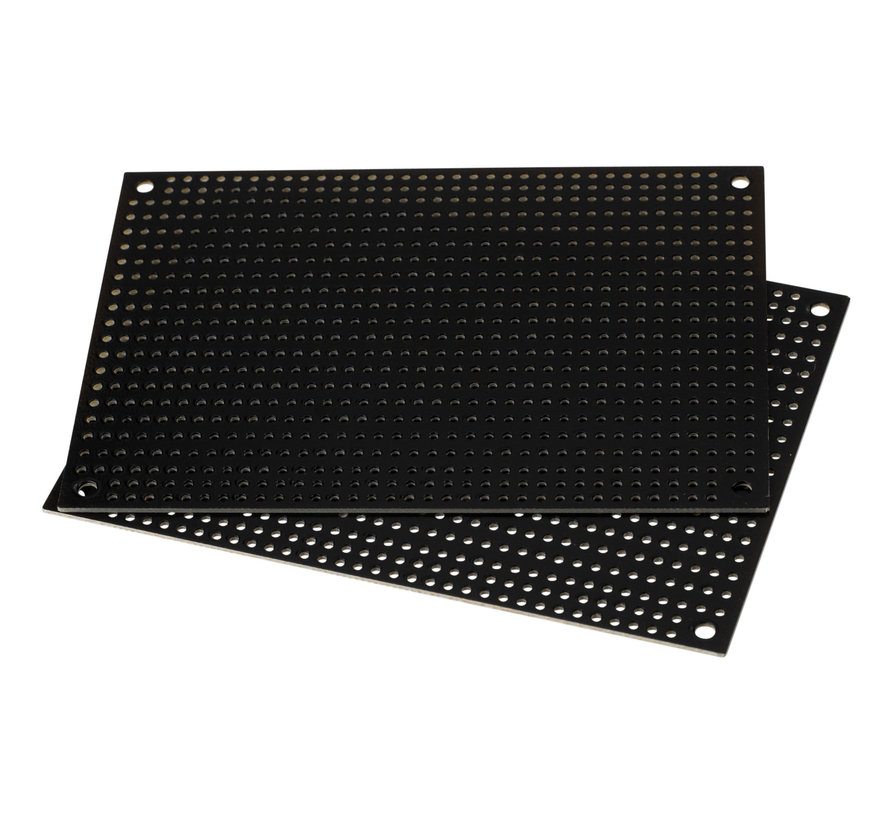
I'll need to cut the boards (went with the black phenolic boards) to get them to fit with the biggest coil. I do have a multi-tool so that should take care of it.
This should work... I hope...
Changed the bigger caps to ClarityCap SA series. They are well regarded affordable capacitors. Bigger than the Audyn I had chosen before, but should be well behaved. Off the slippery slope 😀.
The small ones are still Vishay MKP1837.
Attachments
The ones in my board were Clarity Cap ESA, not sure what the difference is but they are very well made components and not horribly expensive. Very short wire leads though. Solid copper wire from lighting cable or solid mains cable seems to work well for point to point wiring as it has enough strength to hold any shape you care to bend it to.Changed the bigger caps to ClarityCap SA series. They are well regarded affordable capacitors.
The ESA line is one step up from the SA. I figured I had to stop somewhere, as I still have 5 drivers in center without any caps or coils playing the full range. The caps are there to hit the directivity i wanted in the vertical plane. The SA, like the ESA are well build caps with low ESR. I figured using solid core for point to point wiring would be a good idea.
Got some parts in today, the rest of them will arrive tomorrow.
Got some parts in today, the rest of them will arrive tomorrow.
All components are in, I'll try and make a start with the assembly this weekend.
I did not hear back from Mundorf, about that coil test. Too bad... I would have liked to read it.
I've spend a lot of extra time going over my sims to see if i missed anything. On paper this surely seems a worthy upgrade. I do hope it brings as much sonic benefits.
It is close to an expanding array, except for the very top end, but that would bring other drawbacks if we would stick with one driver type. So 5 top drivers playing full range it is. The shaded example even shows a reduction in the upper boost needed (however small). The most important indicator for improvement to me is the 'way smoother boost curve' that only seems to cater to the (combined) TC9 Frequency response.
However, the in room measurements will still show the restlessness of the ceiling splash and other closeby boundaries. I did learn from the sims that vector averaging many positions with this type of array isn't necessarily the best way to go. So I intend to go back to single position measurements, make the correction based on those measurements and make control measurements to see how it does in the directions of interest (up/down, left/right). Possibly tailoring the results with a non vector average as it may result in a wider sweet spot while keeping the benefits of that sweet spot.
I can hardly wait to 'hear' it, but even if it proves to have no sonic benefits, the lessons learned from running these sims will be valuable.
It will be hard to predict anything, but I must say that I've always had a tendency to turn down the upper end a bit compared to the Harmon curves. I've tested many times to bring that top end back up but I never really liked that in the long run. We'll see if this tweak will remedy that a bit.
I did not hear back from Mundorf, about that coil test. Too bad... I would have liked to read it.
I've spend a lot of extra time going over my sims to see if i missed anything. On paper this surely seems a worthy upgrade. I do hope it brings as much sonic benefits.
It is close to an expanding array, except for the very top end, but that would bring other drawbacks if we would stick with one driver type. So 5 top drivers playing full range it is. The shaded example even shows a reduction in the upper boost needed (however small). The most important indicator for improvement to me is the 'way smoother boost curve' that only seems to cater to the (combined) TC9 Frequency response.
However, the in room measurements will still show the restlessness of the ceiling splash and other closeby boundaries. I did learn from the sims that vector averaging many positions with this type of array isn't necessarily the best way to go. So I intend to go back to single position measurements, make the correction based on those measurements and make control measurements to see how it does in the directions of interest (up/down, left/right). Possibly tailoring the results with a non vector average as it may result in a wider sweet spot while keeping the benefits of that sweet spot.
I can hardly wait to 'hear' it, but even if it proves to have no sonic benefits, the lessons learned from running these sims will be valuable.
It will be hard to predict anything, but I must say that I've always had a tendency to turn down the upper end a bit compared to the Harmon curves. I've tested many times to bring that top end back up but I never really liked that in the long run. We'll see if this tweak will remedy that a bit.
Last edited:
This post:
From the thread: https://www.diyaudio.com/forums/multi-way/208799-western-electric-1928-100-a-63.html#post3025100
conveys much of what I'm trying to achieve... In nc535's thread I've shown a comparison between a single driver in a space with floor and ceiling compared to an array (my simmed array to be precise):
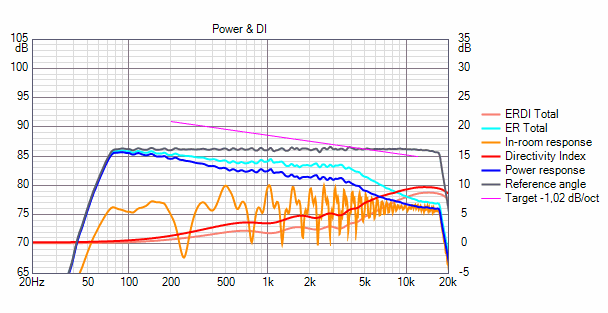
Post: https://www.diyaudio.com/forums/full-range/337956-range-line-array-wall-corner-placement-67.html#post6258352 and the next one...
Everything I've done so far has been to get the array to work with the room to arrive at the above described condition. The mid/side EQ and other experiments have been to improve the conditions to be able to hear the "3D Image" even better.
That's why I think arrays can have their advantages over some other types of speakers "in a room". As soon as one brings a speaker inside a room, all that hard work to get the output right falls to pieces. Unless we cater to that room and the specifics our speakers need.
The comb patterns at the ears is how we determine the shape of the world around us (best done with eyes closed). To get that condition out of two stereo speakers we can help our brain make sense of it. Make it easy to "hide the room" for our brain.
Even the ambience part is catering to that goal. The subs are there for one goal only: increase the headroom. But, as long as they are there, they do help to even out the direct sound, better than I can do with the arrays by themselves. That's why the arrays still cover that bottom part. Because together with the subs I can create a balanced left/right early soundfield.
Every little detail counts to hide the speakers. Diffraction, reflections etc. No sharp corners! Anyway, that is my view on things. And the reason to stick to one format and trying to improve upon it.
It s just like Cheese cake and onions really!
Well to me anyway it looks like it, here is my take.
If one were to set out to describe the taste of cheesecake or onions to someone who had never tasted them, you probably would be able to find words that could give them “a mental picture” of what you’re talking about. In many of the posts here, it seems to me the discussion might be like this issue because until you actually taste these things, you are stuck with what you imagine the words mean and not knowledge of the taste /sensation the words refer to. Like they say, words are only the ladder we climb to grasp a new idea or understanding.
Thus when those who “have heard” try to describe to those who haven’t, the words they use do not convey the emotional experience of hearing it and that leave those who haven’t, wondering what the other have just smoked.
When bear talked about a single wide band source in post #496, point #1 And #2, unless you have heard what this sounds like, the words are just words.
I am not sure I can explain it any better than he can but it is something I have given a lot of thought to developing my own speakers encompassing one and two.
Start with the premise that a loudspeaker transducers job is to reproduce the input signal and nothing more, ideally it produces it with an amplitude proportional to that in the signal AND not producing any sound not part of the input signal AND to do all of that at the same instant in time as they components are present at the terminals.
Most of the “free sound” (not in the input signal) as well as some other problems increase in level faster than the level of the desired signal.
If you start with a loudspeaker that is satisfactory in a movie theater level, when you move that into a living room ALL of that undesirable stuff is greatly reduced as the operating level is greatly reduced compared to the intended use. The WE drivers are old by today’s standards but they were the state of art when made AND are a work of loudspeaker art, the product of a full out engineering and artisan effort and able to fill a theater.
By having one driver cover the range where your ears have the greatest acuity, they accomplished at least two things. With one driver covering that range, the time disparity is solved, the sound is radiated from one time. The acoustic phase one can think of as time as it represents how much the signal is delayed or advanced relative to the input signal. When you audition the phase shift crossovers produce though headphones, one concludes it is mostly not audible. When that effect is produced by two separate sources, there is more to the picture.
We hear in a way that makes this confusing or at least not so obvious. We hear from two points in space but the shape of our head, our ears all cause large changes which to a measurement person look like terrible flaws. We don’t hear the comb filtering, we don’t hear the changing frequency response or any of that stuff as flaws, were not even aware of it.
Instead, that is how we can hear what direction the sound is coming from, how high it is and so on. Our stereo hearing depends on these alterations to derive what to our consciousness is a live 3d stereo image there before us.
The purpose of a stereo is to “fake” this, in my mind it’s ultimate accomplishment is to reproduce another space realistically enough that you can forget it’s not real. My personal goal is eventually to capture and reproduce that live reality. if you’re interested in Stereo imaging, try the recordings at the bottom of the company download page.
These address a different part of the problem, picking up a live image, these being two channels are more or less your visual field of view, 3 additional channels extend the image around in a circle but obviously you can’t do that with head phones.
Anyway, the point is there are BIG ways our ears are different than a mic measurement.
A few examples of “how” the sound is radiated is audible and invisible on a one channel mic.
If you have ever stood in front of a large planar speaker like a full range electrostatic, full height ribbon or other homogeneously driven source, with a soft voice playing through one speaker, you hear a large source, it sounds big and sometimes, if you close your eyes, you really can’t hear how far away the source is, the voice may sound like it’s floating “somewhere” behind the speaker.
Now, how does it sound that way?
It’s because your ears hear a 3d picture even if a mic only senses one spot.
Take a typical small hifi speaker and do the same thing and while it might measure similarly, you will usually be able to also hear the source as the source. Your ears localize the origin because there are enough differences from the right to left that your learned ability allows you to identify where the sound is coming from in physical depth.
Take a Quad esl-63, or a manger bending wave transducer in a quiet place, play a voice through one and with your eyes closed, you will be surprised how little the apparent source is tied to the loudspeakers location, the voice can sound like it is well behind or even in front of the source.
How does it do that? These sources radiate as a simple point source and not a complex field which contains the clues that allow you to hear it’s depth, so now there is no “source identity” that your ears detect.
As the Unity and later Synergy horns got closer and closer to one driver in the output, I noticed this floating voice or source identity effect and was puzzled what it meant.
The WE driver on a proper horn would radiate as a simple source over much of it’s band too.
Who cares?
If you like stereo imaging, not the effects but things, people floating across the stage in front of you, this matters a lot. The mono phantom image is the heart of stereo, if you present two identical signals to your right and left ears, it sounds like its right in front of you (as it does with headphones except your lacking all that external directional head / ear stuff I mentioned earlier).
What harms this is any significant extra information that is not part of the ideal Mono.
If you have a speakers (as the majority of hifi speakers I have heard do) that shouts its physical location “here I am right here”, then while playing the mono signal you hear a mono phantom AND a right and left source.
To the degree they do that, they are greatly harming any ability to produce the original stereo image intensity, THEY should NOT be part of the image.
In commercial sound now, one rough measure of how well you can understand words is how much the direct sound is above the reflected sound level.
Large scale sound generally sucks because as the distance to the audience increases, so does the acoustic power required.
As the room’s volume increases, the surface area where the absorption is, increases at a slower rate than the room volume where the energy is stored. In a movie theater, the directivity the large horn size they used would greatly reduce the reflected energy, for the largest area of intelligibility, you want the sound to go where the people are and not the walls, ceiling or floor.
There is a thread about directivity, a powerful demonstration; set up your stereo outdoors in a normal configuration and listen to some of your favorite music with the best stereo images.
Do this and your feelings about the desirability of room effects will change. Re-creating that experience indoors in a living room requires significant directivity to avoid the room effects.
You set up a set of large Horn like those WE’s and sit in front and guess what, it sounds unreal enough to make most who have listened convinced they were on to something, and they were, even before stereo and that makes it pretty cool I think.
Think about how we hear and how / what we measure.
Lastly, I mentioned closing your eyes a couple times. Also that we have learned what all the artifacts our ears cause and take in are as positional and other spatial ques.
For the most part I don’t think people are aware how much “processing” our brains do for us without our knowledge.
Blind tests have a bad name because they strip away the inputs from other sense and prior knowledge leaving us to judge with only one sense like hearing.
While we see that effort when we take an eye sight or hearing test, there is no red light to indicate the tone and the you read random letters not words you can guess, you either hear or see or not.
Anyway, this is a cool example of how deep the” learned part” of our hearing is and how tightly it is tied to what we see, this is from a show on ones senses which was also amazing.
Try the Mcgurke effect;
Try The McGurk Effect! - Horizon: Is Seeing Believing? - BBC Two - YouTube
You only hear reality with your eyes closed
Best,
Tom Danley
Danley Sound Labs
I like big horns and I cannot lie,
those little horns make me cry.
From the thread: https://www.diyaudio.com/forums/multi-way/208799-western-electric-1928-100-a-63.html#post3025100
conveys much of what I'm trying to achieve... In nc535's thread I've shown a comparison between a single driver in a space with floor and ceiling compared to an array (my simmed array to be precise):
Post: https://www.diyaudio.com/forums/full-range/337956-range-line-array-wall-corner-placement-67.html#post6258352 and the next one...
Everything I've done so far has been to get the array to work with the room to arrive at the above described condition. The mid/side EQ and other experiments have been to improve the conditions to be able to hear the "3D Image" even better.
That's why I think arrays can have their advantages over some other types of speakers "in a room". As soon as one brings a speaker inside a room, all that hard work to get the output right falls to pieces. Unless we cater to that room and the specifics our speakers need.
The comb patterns at the ears is how we determine the shape of the world around us (best done with eyes closed). To get that condition out of two stereo speakers we can help our brain make sense of it. Make it easy to "hide the room" for our brain.
Even the ambience part is catering to that goal. The subs are there for one goal only: increase the headroom. But, as long as they are there, they do help to even out the direct sound, better than I can do with the arrays by themselves. That's why the arrays still cover that bottom part. Because together with the subs I can create a balanced left/right early soundfield.
Every little detail counts to hide the speakers. Diffraction, reflections etc. No sharp corners! Anyway, that is my view on things. And the reason to stick to one format and trying to improve upon it.
- Home
- Loudspeakers
- Full Range
- The making of: The Two Towers (a 25 driver Full Range line array)
